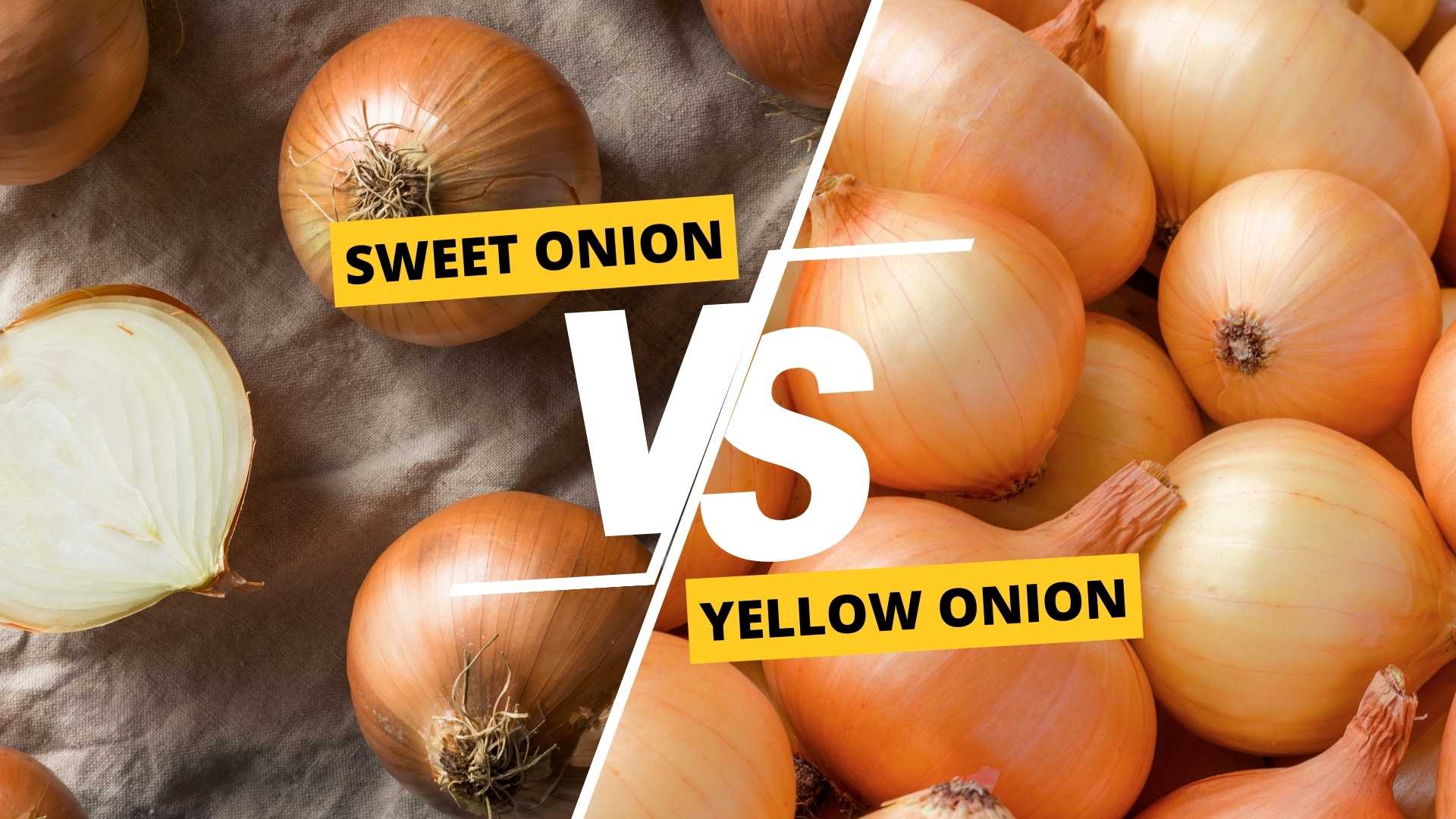Onions are a staple ingredient in many cuisines around the world. Two common types of onions are sweet onions and yellow onions. While they might look similar, there are significant differences between the two.
In this article, we’ll compare sweet onions vs. yellow onions in terms of appearance, flavor, nutrition, cooking uses, availability, price, and recipes. We’ll also provide cooking tips for each type of onion and help you decide which one to choose for your next dish.
Comparison of Sweet Onion vs Yellow Onion
Appearance and Flavor
Sweet onions and yellow onions differ in both appearance and flavor. Sweet onions are larger and flatter than yellow onions, and they have lighter-colored skin. They also tend to be sweeter and milder in flavor than yellow onions.
In contrast, yellow onions have a more intense, pungent flavor and are better suited for savory dishes. Yellow onions are also smaller and rounder than sweet onions and their skin is darker and thicker.
Nutrition
Both sweet onions and yellow onions are low in calories and high in nutrients. However, sweet onions have more sugar and fewer sulfur compounds than yellow onions. This means that sweet onions have a slightly higher calorie count and are less likely to cause tear-inducing reactions when chopped.
On the other hand, yellow onions have more sulfur compounds, which may have health benefits, including reducing inflammation and improving heart health.
Cooking Uses
Sweet onions and yellow onions have different culinary uses. Sweet onions are best used in dishes that require a sweeter, milder flavor, such as salads, sandwiches, and stir-fries.
Yellow onions are better suited for savory dishes, such as stews, soups, and meat dishes. They also work well in caramelized dishes, such as French onion soup and onion tart.
Availability
Sweet onions and yellow onions are grown in different regions and have different growing seasons. Sweet onions are typically grown in the southern United States, particularly in Georgia and Texas, and are available from late spring through the summer.
Yellow onions, on the other hand, are grown in a variety of regions, including the United States, Mexico, and Europe, and are available year-round.
Price
The price of sweet onions vs. yellow onions can vary depending on several factors, including the growing region, time of year, and demand. In general, sweet onions are more expensive than yellow onions due to their limited growing regions and shorter growing seasons. However, the price difference may not be significant, especially if you purchase onions from a local farmer’s market or grocery store.
Recipes
Sweet onions and yellow onions can be used in a variety of recipes. Here are some examples:
- Sweet Onion Recipes: Grilled Sweet Onion Salad, Sweet Onion and Tomato Tart, Sweet Onion and Red Pepper Dip
- Yellow Onion Recipes: French Onion Soup, Beef Stroganoff, Sautéed Onions and Mushrooms
How to Best Use Sweet Onions and Yellow Onions
When selecting sweet onions or yellow onions, look for onions that are firm, heavy for their size, and free of soft spots or mold. To store onions, keep them in a cool, dry, and well-ventilated place, such as a pantry or root cellar. Avoid storing onions with potatoes, as the potatoes can release moisture and cause the onions to spoil more quickly.
To prepare onions, cut off the stem and root ends, and peel off the outermost layer of skin. You can chop or slice the onions as desired, and then cook them using your preferred method. For sweet onions, you may want to use a gentler cooking method, such as sautéing or grilling, to preserve their sweetness. For yellow onions, you can use a variety of cooking methods, including caramelizing, roasting, or frying.
When cooking with onions, it’s important to be patient and allow the onions to cook slowly and evenly. This helps to bring out their natural sweetness and prevent them from burning or sticking to the pan. You can also add a pinch of salt to the onions as they cook, which helps to draw out moisture and enhance their flavor.
Which One Should You Choose?
Choosing between sweet onions and yellow onions depends on the flavor profile you’re looking for in your dish. If you want a sweeter, milder flavor, go for sweet onions. If you want a more intense, pungent flavor, go for yellow onions. Keep in mind that both types of onions have their culinary uses, and you can experiment with using them in different dishes to see which one works best.
Conclusion
In conclusion, sweet onions and yellow onions differ in terms of appearance, flavor, nutrition, cooking uses, availability, and price. Both types of onions are healthy and versatile ingredients that can be used in a variety of recipes.
When cooking with onions, be sure to select onions that are firm, heavy for their size, and free of soft spots or mold. Use a variety of cooking methods to bring out the best flavor in your onions, and experiment with using both sweet onions and yellow onions to find your favorite.
